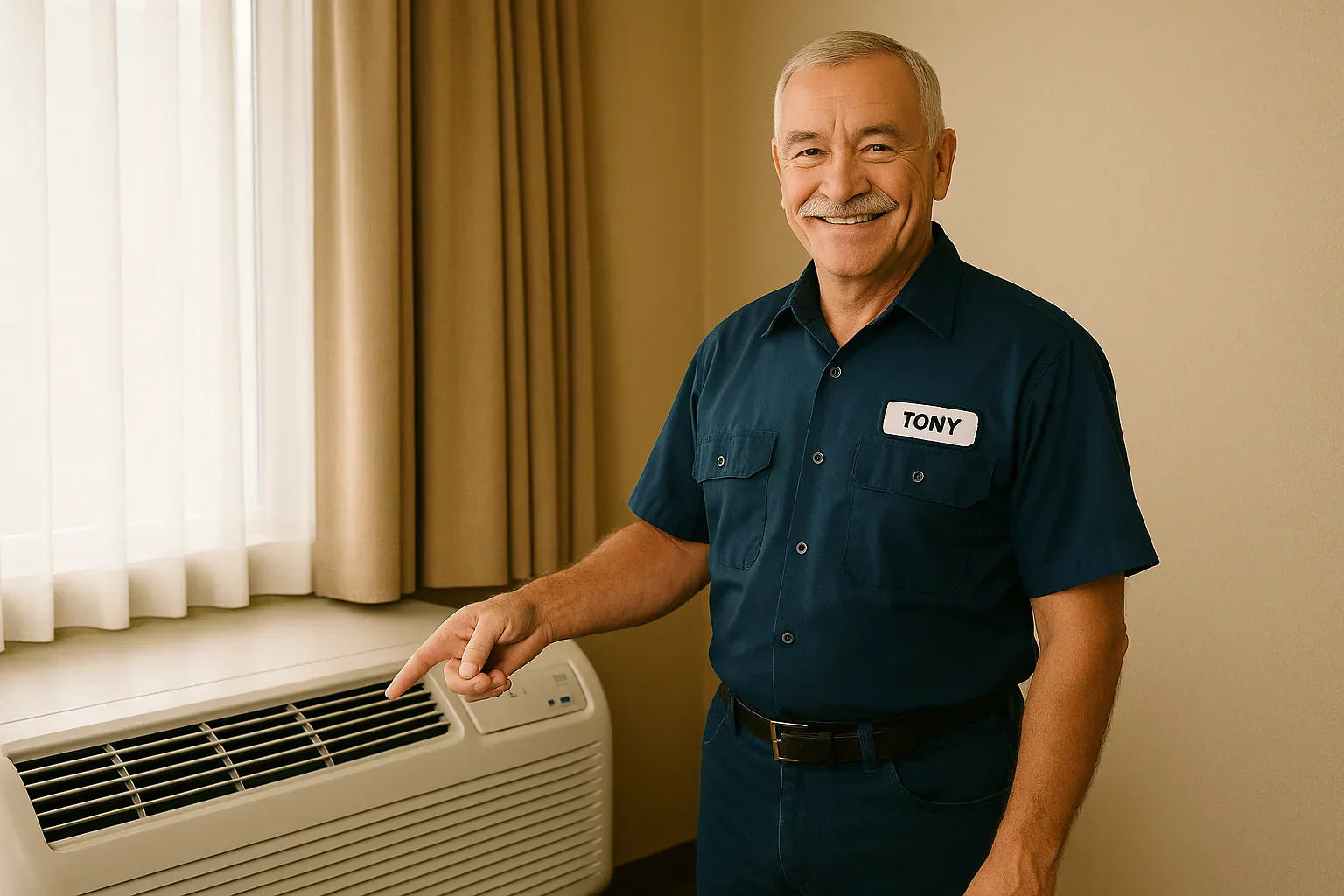🔧 Introduction: Heat Pumps — The Secret Weapon Inside PTACs
Hey folks, Tony here. If you’ve ever stayed in a hotel room and felt nice and toasty on a chilly morning, or cooled down instantly on a hot day — there’s a good chance you’ve been comforted by a PTAC unit with a heat pump built right inside.
But a lot of people ask me:
"Tony, how exactly does that heat pump work? And is it really better than old-school electric heat?"
Let’s break it down, the Tony Marino way.
⚙️ How Heat Pumps Work Inside PTAC Units
Think of a heat pump like a reversible air conditioner.
-
In cooling mode, it pulls heat out of the room and dumps it outdoors.
-
In heating mode, it pulls heat from outside air (even if it’s chilly) and brings it inside.
✅ Key point: You’re moving heat rather than generating it like electric coils do. That’s why heat pumps can be incredibly efficient.
In a PTAC setup:
-
Everything — compressor, fans, coils — is inside one compact unit mounted through the wall.
-
The heat pump operates down to certain outdoor temps, then switches to electric backup when needed.
💡 Tony’s Pro Tip:
"Don’t be fooled by how small the PTAC is — that little box is doing some seriously advanced work."
🌡 Heat Pump vs. Electric Resistance: What’s the Difference?
🔥 Electric Resistance Heat
-
Works like a big toaster.
-
Electrical current heats up metal coils.
-
100% efficient at converting electricity into heat, BUT very energy-hungry.
❄ Heat Pump
-
Moves existing heat rather than creating it.
-
Efficiency often reaches 200-300% (or more), because you get 2-3 units of heat for every unit of electricity.
✅ Bottom line:
The more you can run your PTAC’s heat pump mode, the less you’ll spend on your electric bill.
🔗 Verified Source:
U.S. Department of Energy - Heat Pump Systems
🌎 Regional Considerations: When Does a PTAC Heat Pump Make Sense?
🏖 Southern & Coastal Regions:
-
Heat pump mode works almost year-round.
-
Electric backup rarely kicks in.
-
Excellent efficiency and comfort.
🏙 Moderate Climates (Midwest, Mid-Atlantic):
-
Heat pump runs most of the fall, spring, and milder winter days.
-
Electric backup may kick in during freezing temps.
❄ Northern Regions:
-
Heat pump useful in shoulder seasons.
-
Backup electric kicks in often during deep winter.
-
Still better than resistance-only PTAC for year-round use.
🔗 Verified Source:
Energy Star Climate Guide
💵 Energy Savings Breakdown: Real-World Numbers
| Electric Resistance | Heat Pump PTAC | |
|---|---|---|
| Efficiency (COP) | 1.0 | 2.5 – 3.5 (when mild) |
| Cost per hour (avg) | $0.30 | $0.10 – $0.12 |
| Annual heating cost (hotel room example) | $1,500 | $600 – $900 |
(Estimates based on national average electric rates and typical hotel usage patterns)
🔗 Verified Source:
NRDC - Heat Pumps Save Money
🔈 Comfort Benefits Beyond Just Savings
-
✅ Gentler, steady heat (no blasts of hot air like resistance heat)
-
✅ Quieter operation (less on/off cycling)
-
✅ Better humidity control during summer cooling
-
✅ Less strain on building electrical systems
💡 Tony’s Take:
"I’ve installed PTAC heat pump units in dozens of properties where the owner called me a year later and said — Tony, why didn’t we do this sooner?"
🏢 Best Properties to Use PTAC Heat Pumps
-
🏨 Hotels & Motels
-
🏥 Assisted Living & Healthcare
-
🏘 Multifamily Housing
-
🏡 Senior Living Communities
-
📈 Office Suites or Mixed Use Buildings
🔗 Verified Source:
ASHRAE Journal - Heat Pump Applications
🛑 Common Heat Pump Myths (Let’s Bust ‘Em)
❌ “They don’t work when it’s cold.”
✅ Reality: Modern PTAC heat pumps work down to 20°F or lower — some even colder — before backup heat is needed.
❌ “They’re too expensive to maintain.”
✅ Reality: With regular maintenance (filters, coils, refrigerant checks), heat pumps last as long as electric-only PTACs — often longer.
❌ “They’re complicated for guests or tenants.”
✅ Reality: Controls are simple. One thermostat handles both heating and cooling automatically.
🔗 Verified Source:
Consumer Reports - Heat Pump FAQ
🧰 Maintenance: Keeping Your PTAC Heat Pump Happy
-
🔄 Clean filters monthly (especially in dusty rooms).
-
❄ Check evaporator & condenser coils every season.
-
💧 Ensure drain pans stay clear.
-
🔧 Have a pro check refrigerant levels annually.
💡 Tony’s Pro Tip:
"If your PTAC heat pump is cycling too often or blowing lukewarm air, 9 times out of 10 it’s a dirty coil or filter."
📊 Is a PTAC Heat Pump Right for You? A Quick Scorecard
| Factor | Score |
|---|---|
| Building Type | 🟢 Excellent for hotels, multifamily, healthcare |
| Climate | 🟢 Southern / Coastal = Home Run |
| Energy Cost Savings | 🟢 High Potential |
| Upfront Cost | 🟠 Slightly higher than resistance-only |
| Long-Term ROI | 🟢 Excellent |
🔚 Conclusion: Heat Pump PTACs — Smart, Efficient, Future-Ready
If you own or manage a property that needs individualized room control, and you care about energy savings, comfort, and long-term ROI — PTAC units with heat pumps are one of the smartest moves you can make right now.
As your HVAC guy Tony always says:
"Why keep burning dollars with electric coils when you can move free heat around? That’s what heat pumps do."
👉 Ready to explore models? Start with something like the Amana Distinctions 9000 BTU PTAC Heat Pump — a perfect fit for many properties.
In the next topic we will know more about: What Size PTAC Unit Do You Need? A Room-by-Room Sizing Guide







